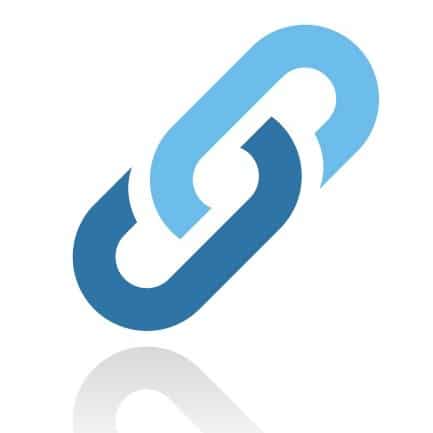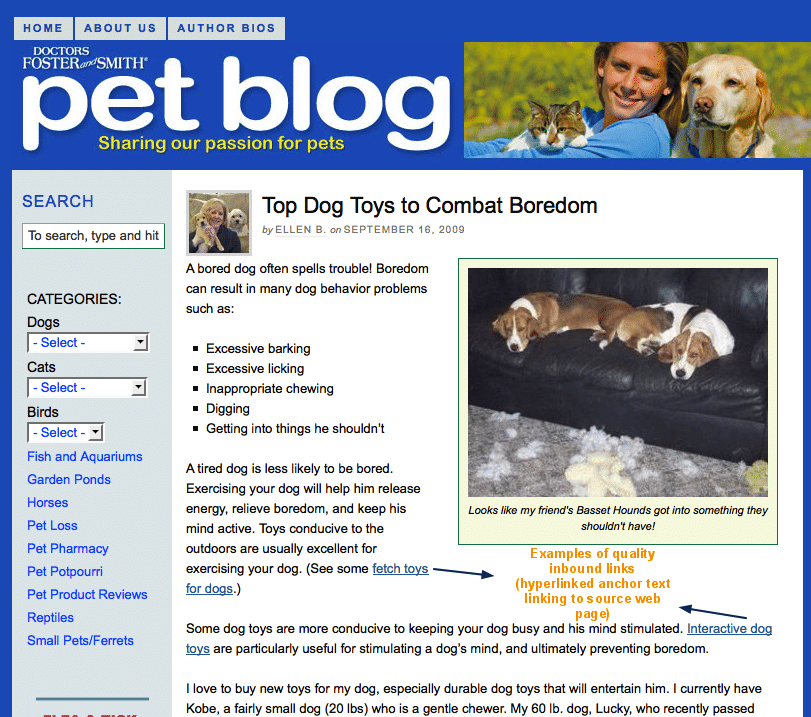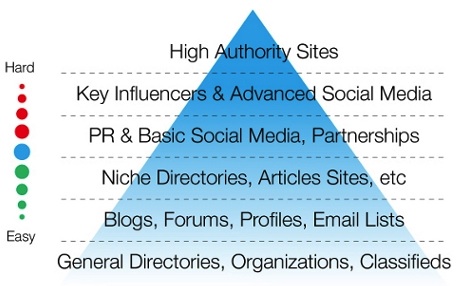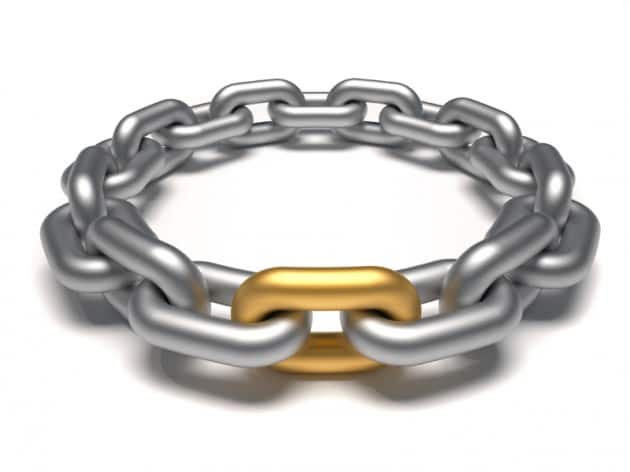If you want your website to rank high in the search engines for its relevant key phrases, then it needs two things: (1) Quality Content and (2) Quality Inbound Links. In this post we are going to help you understand exactly what a “quality link” is and how to actually attain them.
What is a Quality Inbound Link?
We are going to go straight to the source for this one.
“Inbound links are links from pages on external sites linking back to your site. Inbound links can bring new users to your site, and when the links are merit-based and freely-volunteered as an editorial choice, they’re also one of the positive signals to Google about your site’s importance.” – Google Webmaster Central Blog
In other words, if you have a website about Dog Toys, then a quality inbound link would be like the following examples provided in the article below about “Top Dog Toys to Combat Boredom”:
Criteria for a High Quality Inbound Link
To go a little deeper into why the link examples provided above are considered “high quality” it is important to understand the criteria that really make a link effective for your website. Getting a link that meets all, or most, of the following 10 criteria will really help your web page to eventually rank well for its target key phrase(s):
1) Relevancy
The website / web page with the link is “relevant”, in topic / theme, to that of your website
2) Website Age
The age of the website linking to you is as old as possible (preferably more than 2-3 years)
3) Web Page – PageRank
Web Page PageRank is preferably above a PageRank of 2/3
4) Website – PageRank
Overall Site PageRank is preferably above a PageRank of 2/3
5) Dilution
There are less than 20-30 outbound links on the web page where your link is located
6) Anchor Text
The proper anchor text is being used for the link (eg. “popular dog toys” instead of “click here”)
7) Dofollow
The links are “dofollow” meaning the webmaster allows links on the website to pass “link juice” to other websites
8) Credibility
Any external links are of high quality (ie. no links from pages with links to unrelated sites like Gambling, pharma, adult)
9) Link Location
The link is placed as high on the page as possible, preferably surrounded by contextually relevant content
10) Individuality
Each link is coming from a website with a unique IP address (ie. don’t want all links to all come from the same website / IP)
Extra Criteria
On top of these 10 main criteria, there are a couple extra criteria that also contribute to making a link higher quality, and thus, more effective:
1) Trustworthy
Linking website has a “No Disclaimer Policy” stating that the webmaster does not take / receive any sort of paid links, paid reviews, etc.
2) Social
Links come from authoritative social sites like Facebook and Twitter
What are the Different Types of Links?
Quality inbound links can come from many different places on the web. Realistically, you are not going to get links that meet 100% of the criteria listed above every single time. In many cases this is fine though as some lower quality links can still be helpful in proving that your website is a relevant, authoritative resource and also in delivering traffic to your website / blog.
That said, it is important to know what the different types of links are and where they can come from so that you can properly allocate your time and effort when building links.
High Authority Links
Level of Difficulty: HIGH
Value: HIGH
Result: SEO, Traffic, Branding
Authority links are the most valuable types of links you can get for your website. And, at the same time, they are also they most difficult links to get as well. These links take a lot of research, creativity, negotiation and time to attain. These links are an absolute necessity for your website, especially if it is brand new.
TIP: Do a Google Search for your top key phrase, note the top 5 organic results and then research to see who is linking to them. A tool like Yahoo Site Explorer can help you find this information.
Directory Links
Level of Difficulty: LOW
Value: MODERATE
Result: SEO
Although links from directories are starting to lose value due to over saturation, some web directories still provide a significant amount of value as linking sources. Directory links maintain much of their value in their relevance to your website and the history and legitimacy that many of the top ones have accumulated over the past 10 years or so.
TIP: Keep your directory links to less than 15% of your link portfolio
Reciprocal Links
Level of Difficulty: MODERATE
Value: MODERATE
Result: SEO, Traffic
A reciprocal link is simply a link that you have exchanged with another website owner or blogger. In other words, they have placed a link on their website / blog in exchange for you placing a link on your website / blog that points back to their website / blog.
TIP: Keep your reciprocal links to a minimum (less than 10% of your link portfolio) to avoid any unwanted attention from Google. Use them to get new web pages crawled quickly by exchanging links with an authoritative, frequently crawled website.
Sitewide Links
Level of Difficulty: LOW
Value: LOW
Result: SEO
Sitewide links are links that are placed on every page of a single website. Many text link brokers offer these types of links, but too many of these can quickly raise a red flag with Google.
TIP: Unless you are creating websites and have to have your company anchor text link in the footer of every page of the website, then you are better off just completely avoiding these types of links.
One-way Links
Level of Difficulty: HIGH
Value: HIGH
Result: SEO, Traffic
These types of links are most definitely the most coveted types of links as
they can really help to pass some valuable link juice without you have to reciprocate with a link. Like authority links, oneway links are very difficult to attain so you’re going to need to be extremely creative to capture these.
TIP: Personal connections make for fantastic and successful oneway link building strategies. Just remember to try to keep your one way links to sites that are relevant in topic.
3-Way Links
Level of Difficulty: MODERATE
Value: MODERATE
Result: SEO
These types of links are explained as follows: Site A links to Site B. Site B links to Site C. Site C links to Site A. 3-way links are really just another form of reciprocal links and should be limited to a small percentage of your overall link portfolio.
TIP: As with any reciprocal link exchange, make sure to stay on topic and use 3-way linking on a limited basis
.Edu and .Gov Links
Level of Difficulty: HIGH
Value: HIGH
Result: SEO, Traffic, Branding
These types of links are the holy grail (in most cases) for link builders everywhere. These links hold so much value because (in most cases) because these websites hold much more credibility, legitimacy and authority, in the eyes of the search engines, than most commercial websites. These links are at the top of the link pyramid and are extremely difficult to attain without the proper experience or know-how.
TIP: Start with your local colleges and government organizations to discover possible link opportunities from .edu and .gov websites.
Media Links
Level of Difficulty: HIGH
Value: HIGH
Result: SEO, Traffic, Branding
Media links consist of links from websites that belong to or are associated with radio stations, news outlets, newspapers, magazines, etc. These types of links offer value as they typically have strong trust levels with the search engines, but they can often be difficult to find for specific topics you need.
TIP: Build a network of relationships with local, regional and national journalists.
Press Release Links
Level of Difficulty: LOW
Value: LOW
Result: Traffic, Branding
Probably one of the easiest types of links to get, but usually not the most valuable in terms of passing valuable link juice. Theses types of links can be good sources of traffic if your press release is timely and relevant to a trending topic. Press release links are simply attained by submitting press releases online and syndicating them to as many outlets as possible.
TIP: Make sure to implement the proper on-page optimization on your press releases to truly benefit from any links you may get from these.
Article Links
Level of Difficulty: LOW
Value: LOW
Result: Traffic, Branding
Much like Press Release links, article links usually deliver very little value to help your website’s rankings. Again though, if an article is of good enough quality and submitted to the right place at the right time, then you could benefit from some decent traffic and brand support.
TIP: Take the extra time to write some quality content for your article and focus on submitting it to more well known sources like Wikipedia or Google Knol.
RSS Links
Level of Difficulty: LOW
Value: LOW
Result: Traffic
Again, one of the easier types of links to attain, but not the most valuable. These types of links come from blog readers from subscribing to your RSS feed and possibly re-syndicating it for you.
TIP: Google’s newest algorithm update has penalized websites that rely solely on scraping this type of content and re-posting it as their own. This doesn’t affect you as the source, but it should tell you how important Google thinks these related links are.
Comment and Profile Links
Level of Difficulty: MODERATE
Value: MODERATE
Result: SEO
These types of links come from commenting on other websites and blogs and placing your desired link within the comment. These links also come from setting up profiles on websites and placing some relevant information along with links to your website / blog.
TIP: Make sure to verify that the site you are commenting on or the profile you are setting up does not “nofollow” links that people place.
Social Media Links
Level of Difficulty: LOW
Value: HIGH
Result: SEO, Traffic, Branding
These types of links are pretty self-explanatory as they come from social media websites and networks like Facebook and Twitter. Although the level of difficulty in attaining these types of links is relatively low, their value continues to climb as the search engines continue in the direction of using social signals to assist in organic ranking factors.
TIP: Leverage your pre-existing networks on the social media sites you frequent most to get relevant links to your website.
How to Actually Get Links?
Knowing what the different types of links are should help you to decide what types of links you want to go after and how you want to build your link portfolio.
The best types of links come from great content, creativity and actual relationships. If you’re able to produce these then your link building efforts should be fun, exciting and fruitful. If you’re not, then you have a lot of hard work ahead of you. The tips below should get you started either way.
Actionable Ways to Build Links – The 5 B’s
- Buying
- Borrowing
- Begging
- Bartering
- Baiting
Link Buying
Although link buying is “frowned upon” by Google, many people have done it, do it now and will continue to do it as it is one of the best ways to get quality links.
DO THIS: Find a website that you really want a link from and make the website owner an offer to compensate them if they place a link on their website back to yours. Make it a no-brainer for them by (1) offering reasonable compensation and (2) providing all necessary HTML and instructions.
DON’T DO THIS: Pay a link broker to place links for you on websites within their “link network”, which usually consists of low quality websites with links to many other websites.
Link Borrowing
Like link buying, link borrowing involves some type of compensation (financial is usually best) for a web master to place a link on their website back to yours. The payment, in this case, would not be front loaded, but rather spread over a period of time or tied to some type of metric increase (eg. traffic, sales, etc).
DO THIS: Offer a website owner that you want a link from a percentage of sales made as a direct result of the traffic increase provided by the link they place for you.
DON’T DO THIS: Pay monthly for a “leased” link that the website owner could potentially take down at their will after you have already fronted some money for the link.
Link Begging
This is all about selling your website as a resource to the website owner that you’re trying to get a link from. If you are able to convince them that there is some benefit in them placing a link on their website back to yours then you have successfully begged for a link.
DO THIS: Direct the website owner that you want a link from to an authoritative / useful / relevant page on your website to convince them that their website would benefit from linking to you. If you can make them feel comfortable with their website visitors leaving their website to go to yours then you will be set.
DON’T DO THIS: Send impersonal email blasts to website owners. Website owners get enough of this spam as it is already.
Link Bartering
Pretty self-explanatory, but this all about exchanging something of value for a link on the website you wish to get a link from. Link bartering can be a very effective, and inexpensive, way to get the links you need.
DO THIS: Find the website you want to get a link from, get in touch with the webmaster and offer them something of value (eg. free product of yours, gift certificate, link from another website you own) in exchange for a link on their website.
DON’T DO THIS: Offer them a reciprocal link. You want to try and avoid filling your link portfolio with reciprocal links.
Link Baiting
By far the most effective, and natural, way to build quality links is through link baiting. Link baiting involves the creation of content to naturally attract relevant inbound links to your website or blog.
DO THIS: Create a series of TOP 3 articles on your website / blog that features the top 3 products / companies that are relevant to your business. Contact these businesses to let them know about the article, which, if positive, is usually something that they will want to repost or promote on their website.
DON’T DO THIS: Publish controversial articles just for the sake of being controversial or of which features inaccurate information about mentioned companies. Bad publicity is usually good in some way, but karma usually gets it way so do what’s right.
Build Your Link Portfolio…for the Right Reasons
Link building is one of the most effective ways to get your website ranked highly in the search engines. Link building works so well because it helps the search engines to see your website / blog as an authority and popular destination for its users.
When it comes down to it, the web is really just a popularity contest and links are the votes of popularity your website needs to be seen online.
All of this aside, it is crucial to understand why you’re really building links in the first place. Organic rankings are essential for just about every business these days. However, many people get so focused on the actual rankings themselves as the goal of their link building campaign and forget what link building, and all other online marketing strategies, are really all about….
Driving as many relevant, targeted visitors to your website to create as many opportunities as possible for these visitors to become leads / customers.
So remember, as you start your link building campaign, or continue to work on your existing one, ask yourself these questions:
- Will this link drive the right kind of traffic to my website / blog?
- Does this link compliment my website’s content / theme?
- Will my website get more business as a result of having this link?
Good luck with your link building endeavors. Hopefully the information above will prove useful as you decide where to spend your link building efforts. Feedback is welcomed. So, if you have some link building concepts or ideas that you don’t mind contributing then please LEAVE A COMMENT BELOW.
If you found this post useful, then please link to it by copying the HTML below and placing it on your website :)
<a href=”https://www.businessmarketingblog.org/understanding-link-building” target=”_blank”>Understanding Link Building</a>





